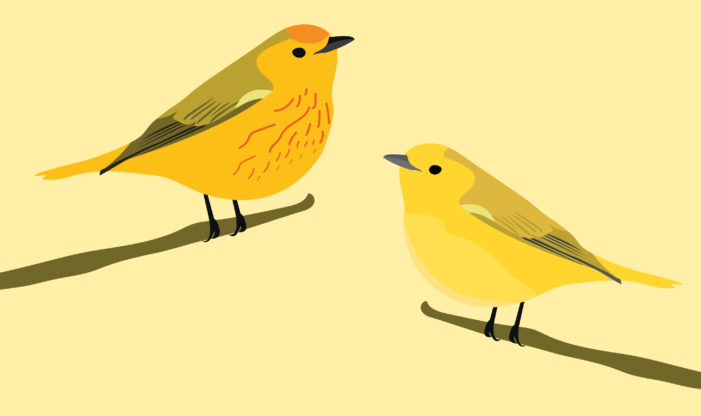The Yellow Warbler (Setophaga petechia) arrives with the first wave of warbler species to migrate through Wisconsin. Many people delight in seeing these colorful songbirds every spring.
After their long journey from wintering grounds in Central and South America, Yellow Warblers arrive in Wisconsin in May, stay through the summer, then journey back south during fall migration. They have a widespread range, breeding throughout the northern half of the United States and most of Canada. Look for Yellow Warblers in wet deciduous thickets, shrubby areas, and early successional habitats. They prefer wet areas dominated by willows. This habitat type is scattered throughout the Center’s land where we have confirmed breeding Yellow Warblers over the years.
Identifying the Yellow Warbler
Like other warbler species, Yellow Warblers are active foragers, feeding mostly on insects and occasionally on wild fruits. You may see them flitting around in trees and shrubs as they hunt for insects. Warblers overall can be tricky to identify, but when you know what to look for Yellow Warblers stand out. While many warbler species display some yellow in their plumage, the aptly named Yellow Warbler appears to be completely washed in yellow.
They have large black eyes which contrast with their plain yellow face. The top of their head and back may look yellow-green or olive, and they have yellow wing bars. Yellow spots in the tail feathers that look like large patches distinguish this species from other North American warblers. Males display rusty or chestnut-colored streaks on their chests, while females may show some paler streaking. Generally, females and immature males look like toned-down versions of the bright yellow breeding males.
Scientists have classified several different groups and subspecies of Yellow Warblers, referred to as forms. The Yellow form is described here and found across North America during the breeding season. In the Golden form, males feature a chestnut cap, and in the Mangrove form the male’s entire head is chestnut colored. The Golden and Mangrove forms are found in Mexico, Central and South America, and the Caribbean, but do not migrate north.
Nesting Habits of Yellow Warblers
In spring and summer, listen for the male’s whistling song of “sweet sweet I’m so sweet,” especially near willows and other small trees and shrubs where they nest. The female builds a cup-shaped nest, typically about ten feet up from the ground, composed of grasses, plant fibers, strips of bark, and even spider webs! She then lines the inside of the nest with soft materials like deer hair, feathers, and fibers from cottonwood, dandelion, willow, and cattail seeds. The female alone incubates the eggs, and the male may bring her food while she is on the nest. Average clutch size is 4-5 eggs with one to two broods produced in a season. Young will leave the nest about 8-10 days after hatching.
Yellow Warblers and Brood Parasitism
Yellow Warblers frequently contend with the obstacle of Brown-headed Cowbirds laying eggs in their nests. This behavior, known as brood parasitism, was once confined to the short-grass plains of North America where Brown-headed Cowbirds followed bison herds, feeding on the insects they stirred up. After European settlement, when forests were cleared for agriculture and development, Brown-headed Cowbirds expanded their range across the continent as they successfully adapted to the human-altered environment. This has put increasing pressure on more than 220 bird species affected by brood parasitism.
The Yellow Warbler is one of the few species that can recognize cowbird eggs in their nests. The eggs are too large to remove, so when they are discovered, the female will build a new nest right on top of the original nest and cowbird eggs (her own eggs are often in the nest too). This may occur multiple times in a season, with nests containing up to six tiers!
Although they are one of the most numerous and widespread warbler species in North America, Yellow Warbler populations have been slowly declining in recent decades. Our conservation efforts provide essential habitat for this warbler species. Visit the Center to see the wonderful Yellow Warbler and other warblers during spring migration in May.


